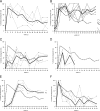Reservoir competence of various rodents for the lyme disease Spirochete Borrelia spielmanii
- PMID: 21460106
- PMCID: PMC3127595
- DOI: 10.1128/AEM.00022-11
Reservoir competence of various rodents for the lyme disease Spirochete Borrelia spielmanii
Abstract
To determine whether the pathogenic Lyme disease spirochete Borrelia spielmanii is adapted exclusively to garden dormice, we compared the reservoir competence of various rodent species for this spirochete, including sympatric and peridomestic rodents. The different kinds of rodents varied in their attractiveness to nymphal ticks and their level of susceptibility to tick-borne B. spielmanii infection, but only the edible dormouse appeared to be refractory. Although hazel dormice and Norway rats became infectious to ticks somewhat later than did garden dormice, they remained infectious for a longer period of time. During the course of a tick season, garden and hazel dormice contributed theoretically more than twice as many B. spielmanii-infected ticks than the somewhat less susceptible Norway rats and wood or yellow-necked mice. Hazel dormice appeared to be extraordinarily competent as reservoir hosts for B. spielmanii. Because peridomestic rodents proved to be reservoir competent, urban foci of transmission of B. spielmanii may affect the health of townspeople.
Figures


Similar articles
-
Seasonal prevalence of Lyme disease spirochetes in a heterothermic mammal, the edible dormouse (Glis glis).Appl Environ Microbiol. 2014 Jun;80(12):3615-21. doi: 10.1128/AEM.00251-14. Appl Environ Microbiol. 2014. PMID: 24705325 Free PMC article.
-
Amplifying role of edible dormice in Lyme disease transmission in central Europe.J Infect Dis. 1994 Jul;170(1):122-7. doi: 10.1093/infdis/170.1.122. J Infect Dis. 1994. PMID: 8014486
-
Characteristics of garden dormice that contribute to their capacity as reservoirs for lyme disease spirochetes.Appl Environ Microbiol. 1999 Feb;65(2):707-11. doi: 10.1128/AEM.65.2.707-711.1999. Appl Environ Microbiol. 1999. PMID: 9925604 Free PMC article.
-
Multi-trophic interactions driving the transmission cycle of Borrelia afzelii between Ixodes ricinus and rodents: a review.Parasit Vectors. 2015 Dec 18;8:643. doi: 10.1186/s13071-015-1257-8. Parasit Vectors. 2015. PMID: 26684199 Free PMC article. Review.
-
European reservoir hosts of Borrelia burgdorferi sensu lato.Zentralbl Bakteriol. 1998 Mar;287(3):196-204. doi: 10.1016/s0934-8840(98)80121-7. Zentralbl Bakteriol. 1998. PMID: 9580423 Review.
Cited by
-
Travelling between Two Worlds: Complement as a Gatekeeper for an Expanded Host Range of Lyme Disease Spirochetes.Vet Sci. 2016 Jun 14;3(2):12. doi: 10.3390/vetsci3020012. Vet Sci. 2016. PMID: 29056721 Free PMC article. Review.
-
When a patient suspected with juvenile idiopathic arthritis turns out to be diagnosed with an infectious disease - a review of Lyme arthritis in children.Pediatr Rheumatol Online J. 2017 May 8;15(1):35. doi: 10.1186/s12969-017-0166-0. Pediatr Rheumatol Online J. 2017. PMID: 28482848 Free PMC article. Review.
-
Transmission differentials for multiple pathogens as inferred from their prevalence in larva, nymph and adult of Ixodes ricinus (Acari: Ixodidae).Exp Appl Acarol. 2017 Feb;71(2):171-182. doi: 10.1007/s10493-017-0110-5. Epub 2017 Mar 2. Exp Appl Acarol. 2017. PMID: 28255923
-
Co-Occurrence of Borrelia burgdorferi Sensu Lato and Babesia spp. DNA in Ixodes ricinus Ticks Collected from Vegetation and Pets in the City of Poznań, Poland.Pathogens. 2024 Apr 10;13(4):307. doi: 10.3390/pathogens13040307. Pathogens. 2024. PMID: 38668262 Free PMC article.
-
Is Borrelia burgdorferi Sensu Stricto in South America? First Molecular Evidence of Its Presence in Colombia.Trop Med Infect Dis. 2022 Dec 11;7(12):428. doi: 10.3390/tropicalmed7120428. Trop Med Infect Dis. 2022. PMID: 36548683 Free PMC article.
References
-
- Becker K. 1978. Rattus norvegicus (Berkenhout, 1769)-Wanderratte, p. 401–416 In Niethammer J., Krapp F. (ed.), Handbuch der Säugetiere Europas, vol. 1/I Akademische Verlagsgesellschaft, Wiesbaden, Germany
-
- Derdáková M., Beati L., Pet'ko B., Stanko M., Fish D. 2003. Genetic variability within Borrelia burgdorferi sensu lato genospecies established by PCR-single-strand conformation polymorphism analysis of the rrfA-rrlB intergenic spacer in Ixodes ricinus ticks from the Czech Republic. Appl. Environ. Microbiol. 69:509–516 - PMC - PubMed
-
- Dsouli N., et al. 2006. Reservoir role of lizard Psammodromus algirus in transmission cycle of Borrelia burgdorferi sensu lato (spirochaetaceae) in Tunisia. J. Med. Entomol. 43:737–742 - PubMed
-
- Fingerle V., et al. 2008. Epidemiological aspects and molecular characterization of Borrelia burgdorferi sl. from southern Germany with special respect to the new species Borrelia spielmanii sp. nov. Int. J. Med. Microbiol. 298:279–290 - PubMed
Publication types
MeSH terms
LinkOut - more resources
Full Text Sources

